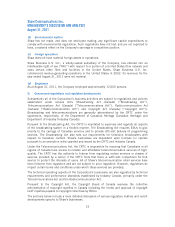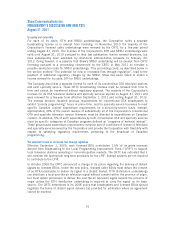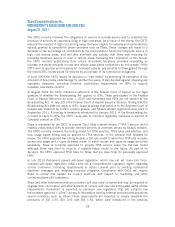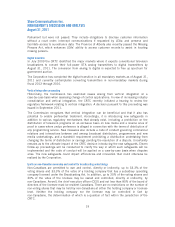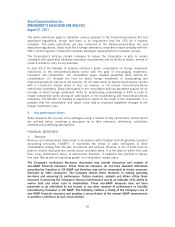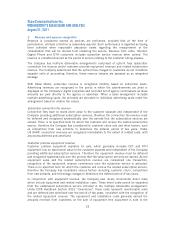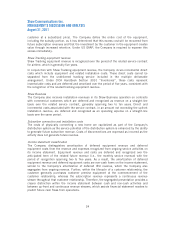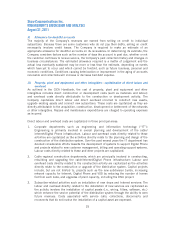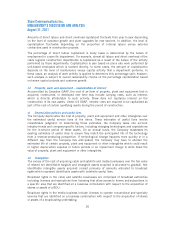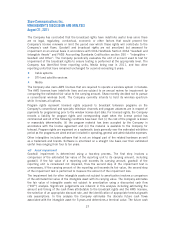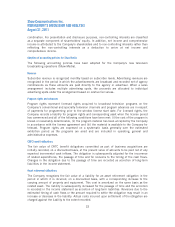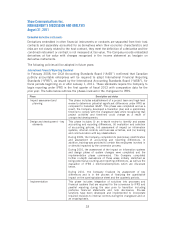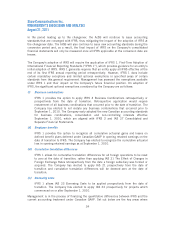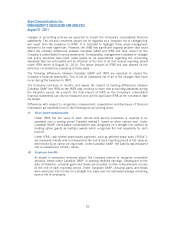Shaw 2011 Annual Report Download - page 29
Download and view the complete annual report
Please find page 29 of the 2011 Shaw annual report below. You can navigate through the pages in the report by either clicking on the pages listed below, or by using the keyword search tool below to find specific information within the annual report.Shaw Communications Inc.
MANAGEMENT’S DISCUSSION AND ANALYSIS
August 31, 2011
ii) Allowance for doubtful accounts
The majority of the Company’s revenues are earned from selling on credit to individual
subscribers. Because there are some customers who do not pay their debts, selling on credit
necessarily involves credit losses. The Company is required to make an estimate of an
appropriate allowance for doubtful accounts on its receivables. In determining its estimate, the
Company considers factors such as the number of days the account is past due, whether or not
the customer continues to receive service, the Company’s past collection history and changes in
business circumstances. The estimated allowance required is a matter of judgement and the
actual loss eventually sustained may be more or less than the estimate, depending on events
which have yet to occur and which cannot be foretold, such as future business, personal and
economic conditions. Conditions causing deterioration or improvement in the aging of accounts
receivable and collections will increase or decrease bad debt expense.
iii) Property, plant and equipment and other intangibles—capitalization of direct labour and
overhead
As outlined in the CICA Handbook, the cost of property, plant and equipment and other
intangibles includes direct construction or development costs (such as materials and labour)
and overhead costs directly attributable to the construction or development activity. The
Company capitalizes direct labour and direct overhead incurred to construct new assets,
upgrade existing assets and connect new subscribers. These costs are capitalized as they are
directly attributable to the acquisition, construction, development or betterment of the networks
or other intangibles. Repairs and maintenance expenditures are charged to operating expenses
as incurred.
Direct labour and overhead costs are capitalized in three principal areas:
1. Corporate departments such as engineering and information technology (“IT”):
Engineering is primarily involved in overall planning and development of the cable/
Internet/Digital Phone infrastructure. Labour and overhead costs directly related to these
activities are capitalized as the activities directly relate to the planning and design of the
construction of the distribution system. Over the past several years the IT department has
devoted considerable efforts towards the development of systems to support Digital Phone
and projects related to new customer management, billing and operating support systems.
Labour costs directly related to these and other projects are capitalized.
2. Cable regional construction departments, which are principally involved in constructing,
rebuilding and upgrading the cable/Internet/Digital Phone infrastructure: Labour and
overhead costs directly related to the construction activity are capitalized as the activities
directly relate to the construction or upgrade of the distribution system. Capital projects
include, but are not limited to, projects such as the new subdivision builds, increasing
network capacity for Internet, Digital Phone and VOD by reducing the number of homes
fed from each node, and upgrades of plant capacity, including the DNU project.
3. Subscriber-related activities such as installation of new drops and Internet services: The
labour and overhead directly related to the installation of new services are capitalized as
the activity involves the installation of capital assets (i.e., wiring, filters, software, etc.)
which enhance the service potential of the distribution system through the ability to earn
future revenues. Costs associated with service calls, collections, disconnects and
reconnects that do not involve the installation of a capital asset are expensed.
25


